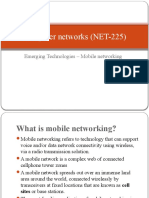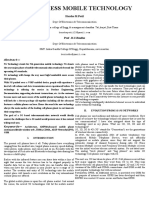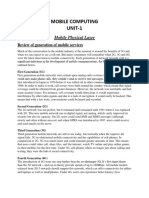Network Access for Mobile Phones
Introduction
In today’s digital age, mobile phones have become indispensable tools for communication, work, and
entertainment. One of the key features that make mobile phones so powerful is their ability to access various
networks, enabling users to stay connected virtually anywhere. This article delves into the specifics of network
access for mobile phones, exploring the types of networks, how they work, and their impact on our daily lives.
Types of Networks
Cellular Networks
2G, 3G, 4G, and 5G: Cellular networks have evolved significantly over the years. Each generation offers
improvements in speed, capacity, and reliability.2G: Introduced digital voice and basic data services.
3G: Brought faster data speeds and mobile internet.
4G: Enhanced data speeds, enabling high-definition video streaming and faster downloads.
5G: The latest generation, offering ultra-fast speeds, low latency, and the ability to connect more devices
simultaneously.
Wi-Fi Networks
Home and Public Wi-Fi: Wi-Fi networks provide wireless internet access within a limited range, such as homes,
offices, and public places like cafes and airports. Wi-Fi is often preferred for its high-speed internet access and
cost-effectiveness, especially in areas with strong coverage.
Bluetooth
Short-Range Connectivity: Bluetooth is used for connecting devices over short distances, such as pairing a
phone with wireless headphones, speakers, or other peripherals. While not used for internet access, it plays a
crucial role in device-to-device communication.
Satellite Networks
Remote Connectivity: In areas where cellular and Wi-Fi networks are unavailable, satellite networks provide an
alternative. These networks are essential for remote locations, such as rural areas, ships, and aircraft.
How Network Access Works
SIM Cards
Subscriber Identity Module (SIM): A SIM card is a small chip inserted into a mobile phone that stores the user’s
subscription information and allows the phone to connect to a cellular network. It contains a unique identifier
(IMSI) that the network uses to authenticate the user.
Radio Frequencies
Spectrum Allocation: Mobile phones communicate with cellular towers using radio frequencies. Different
frequencies are allocated for different types of networks (e.g., 4G, 5G). The phone’s antenna receives and
transmits signals to and from the nearest cell tower.
Network Switching
Seamless Connectivity: Modern mobile phones can switch between different types of networks (e.g., from Wi-
Fi to cellular) seamlessly. This ensures continuous connectivity, even when moving between areas with
different network coverage.
Impact on Daily Life
Communication
Voice and Video Calls: Network access enables voice and video calls, allowing people to stay in touch with
family, friends, and colleagues, regardless of their location.
Internet Access
�Browsing and Streaming: High-speed network access allows users to browse the internet, stream videos, and
use social media platforms effortlessly.
Work and Productivity
Remote Work: With reliable network access, mobile phones have become essential tools for remote work,
enabling email communication, video conferencing, and access to cloud-based applications.
Navigation and Location Services
GPS and Maps: Network access enhances the functionality of GPS and mapping services, providing real-time
navigation and location-based services.
Conclusion
Network access is a fundamental aspect of mobile phone functionality, enabling a wide range of services that
enhance our daily lives. From cellular networks to Wi-Fi and Bluetooth, the ability to connect to different
networks ensures that we remain connected, informed, and productive, no matter where we are. As technology
continues to evolve, the future promises even more advanced and seamless network access, further integrating
mobile phones into every aspect of our lives.




















































































